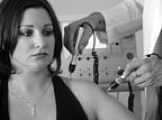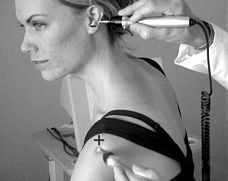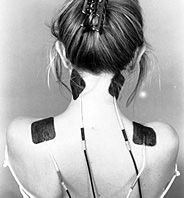One of the longest nerves in the body is known as the vagus nerve (VN). The VN is the 10th pair of cranial nerves that originates at the brain stem in the medulla oblongata. This nerve is part of the parasympathetic nervous system, which is a part of the ANS. Research suggests ear acupuncture can activate the VN.
Sequence Therapy
The art of effective chronic pain relief is similar to peeling an onion. This is because the body tends to "unwind" trauma and pain in layers. Just doing one microcurrent or acupuncture technique is rarely as effective as performing a sequence of brief techniques that disperse blockage (resistance), balance body polarities, activate microsystems and accelerate rehabilitation and tissue regeneration. The best way to use this sequence approach is to select one or more tests that measures improvement in the patient. These can include: range of motion or muscle-strength testing; subjective pain perception upon movement; and kinesiology on ah-shi or meridian test points. Once baseline is determined, the following techniques can be used and the baseline retested after each technique. You will quickly see which technique, or combination of techniques, produces the greatest improvement. Do not overtreat.
Probe Techniques
Make sure you use the equipment search function to locate most conductive points prior to treating with probes. The addition of indicated color light will greatly amplify the effectiveness of all techniques.

Circling The Dragon (Biphasic polarity, square waveform): Used for local treatment of myofascial and joint pain. Both probes are close together, passing current through affected areas. Try this first, re-test, then use other techniques as needed.

Polarized Probes (Trigger probe -, counter probe +, square waveform): Probes are widely separated on body. Used for most acupuncture meridian work, treatment of holographic microsystem points and mu shu technique.

Extremity Treatments: Option 1 would use + probe closer to spine (proximal) on arm or leg, - probe farther from spine (distal), with both probes in same quadrant of body.
Option 2 would use + probe on pain area, - probe on tender reflex point(s) on opposite quadrants of body.

Micro-Macro Treatments: + probe on painful body area or Mu point of affected organ and the - probe on corresponding ear or Korean hand point (using auricular probe tip).
Acute Probes (Biphasic polarity, modified square waveform with brief milliamp spike at start of wave): Pinch trigger points, muscular knots or nonmalignant tumors between probe tips and treat from several directions. Used to release tension, accumulations.

Pad Techniques
Microcurrent Interferential (square or slope waveform, biphasic polarity): Apply four-pad placements, using two intersecting circuits, often with simultaneous exercise, massage and physical therapies. Excellent for post-injury rehab and neuromuscular re-education.

Milliamp-Microamp Combo Interferential: High-frequency milliamp interferential followed by low-frequency microcurrent interferential on same treatment areas. Excellent for treatment of acute pain and injuries, particularly of the low back. Well complemented by needle treatment of distal and micro-system points.
Valuable Strategies
Re-test patient's pain level and range of motion after each technique so you know what is working. Try a series of techniques until you get positive results. A good sequence is: Circling The Dragon, polarized probes, then microcurrent interferential with active motion. Consider doing global meridian balancing prior to symptom level treatment. For instructions, see Chapters 11 and 16 in Microcurrent Electro-Acupuncture book (available from www.east-westseminars.com). Add simultaneous or sequential color light to your acupuncture and microcurrent treatments as much as possible for maximum mind-body balancing effects. Blue and Purple light are generally most valuable for pain relief treatments.


